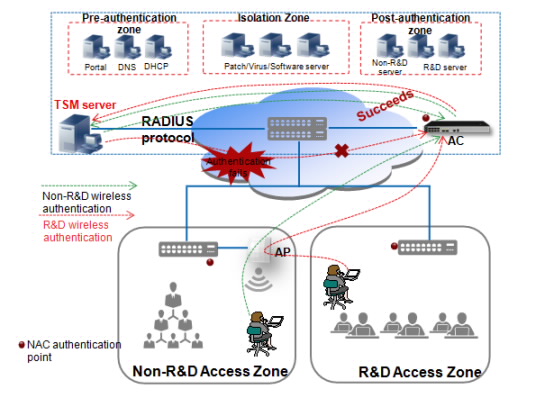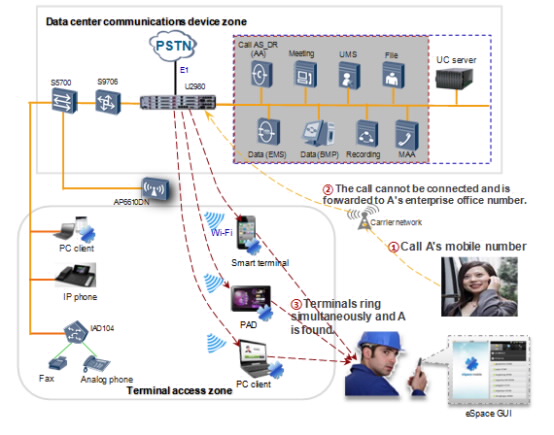The initial scale of lightweight manufacturing campus is small with a limited office area. R&D and non-R&D personnel work in the same office building. The small campus has no dedicated large-sized equipment room to deploy a data center. These manufacturing campuses are very sensitive to content session costs due to limited capital investments. They also divide IT system construction into several phases. During the early development stage, these campuses require that the IT system satisfy the basic operation and office requirements and the requirements for fast capacity expansion in subsequent stages.
The initial scale of lightweight manufacturing campus is small with a limited office area. R&D and non-R&D personnel work in the same office building. The small campus has no dedicated large-sized equipment room to deploy a data center. These manufacturing campuses are very sensitive to content session costs due to limited capital investments. They also divide IT system construction into several phases. During the early development stage, these campuses require that the IT system satisfy the basic operation and office requirements and the requirements for fast capacity expansion in subsequent stages.
Needs
High density
- The office areas are compact. R&D and non-R&D personnel work in office areas that are close to each other. No physical methods are used. As a result, there are potential risks in core R&D information assets leakage.
- The data center equipment rooms are small in size. Network devices, servers, and storage devices are dispersedly deployed in multiple rooms.
Elastic expansion
- The IT system architecture must be stable and scalable. That is, the IT system architecture planned in the early phase must adapt to the future rapid service growth.
- Network devices, storage devices, and core servers must work in redundancy backup mode to ensure highly reliable core services and sustainable development.
Cost-effectiveness
- On the basis of ensuring the basic network communication, computing, storage, communication, and information security, the customer puts minimum investments.
- All employees are allocated with the same smart terminal to reduce communication costs using unified communication methods.
Challenges
Based on analysis of the customer's characteristics, it can be seen that the customer's IT system faces the following challenges:
Challenge 1: information security problems in high-density office conditions:
- The office areas are compact. Non-R&D terminals connect to ports on devices in the R&D office area, resulting in possible core R&D information assets leakage.
- R&D personnel access non-R&D office areas through the Wi-Fi network and can send core R&D information assets to external networks.
Challenge 2: how to build a cost-effective and scalable data center:
- The data center equipment rooms are small in size. As a result, device installation, cable layout, device migration, and capacity expansion are difficult.
- The scale of lightweight manufacturing enterprises is small but their subsequent service development speed is high. To ensure investments into data centers are not too high and the system is scalable, reliable networking must be taken into accounts during early planning of data centers to ensure network architecture stability during subsequent capacity expansion.
Challenge 3: how to solve the problems of weak mobile signals and reduce communication costs:
- Employees on campus have high mobility. As a result, a cost-effective mobile and unified communication solution is required.
- The campus is remotely located. As a result, a mobile communication solution that can replace communication through mobile phones is required.
ICT solution for small manufacturing campus
Put forth the all-member authentication solution that allows a certain employee to access core assets through a certain network to meet information security requirements in high-density office areas. Specific ICT requirements for information security are as follow
- Access to core R&D assets through dedicated networks. Part of the internal enterprise network must be used as R&D network that is isolated from other networks to allow employees access core R&D assets in the specified areas (for example, R&D area) inside the campus.
- Only specified personnel can access core R&D assets. Only R&D personnel and terminals can access the R&D network and can access the core R&D assets within the range of rights.
- R&D personnel cannot access wireless networks.

Figure Centralized wireless access authentication
Put forth a highly scalable and reliable data center solution to satisfy the customer's data center requirements. Specific ICT requirements for a highly scalable and reliable data center are as follows:
- Use the MicroDC3000H integrated data center. Huawei MicroDC3000H is a micro data center that integrates power supply and distribution devices, chassis, heat dissipation, network devices, servers, security, cloud operating system, and integrated management software. Dimensions (W x D x H) of the chassis are 42 U (2000 mm × 600 mm × 1200 mm). The chassis covers a land area of only 0.72 m².
- Key nodes work in redundancy backup mode. Core service servers, switches, and storage devices use dual nodes and dual links. Core services are deployed in cluster mode. Data is copied at two storage devices simultaneously and is backed up to physical tape libraries through the IP periodically to ensure high data security and reliability.

Figure MicroDC integrated solution
Put forth a mobile UC solution to satisfy the customer's requirements for cost-effective and mobile UC. Specific ICT requirements for cost-effective and mobile UC are as follows:

Figure Mobile communications solution overview
- Voice over WLAN (VoWLAN): Huawei eSpace client is installed on mobile terminals, and wireless networks are used to transmit services to implement clear and smooth IP voice communication between internal employees inside the campus and employees outside the campus. This supplements carrier network signals inside the campus.
- One number for one employee: Enterprise numbers that use wireless networks can be bound to mobile phone numbers. Each employee has only one enterprise number.
- Adapt to growth of the number of employees. Private branch exchanges (PBXs) have high scalability to adapt to the growth of the number of employees.



